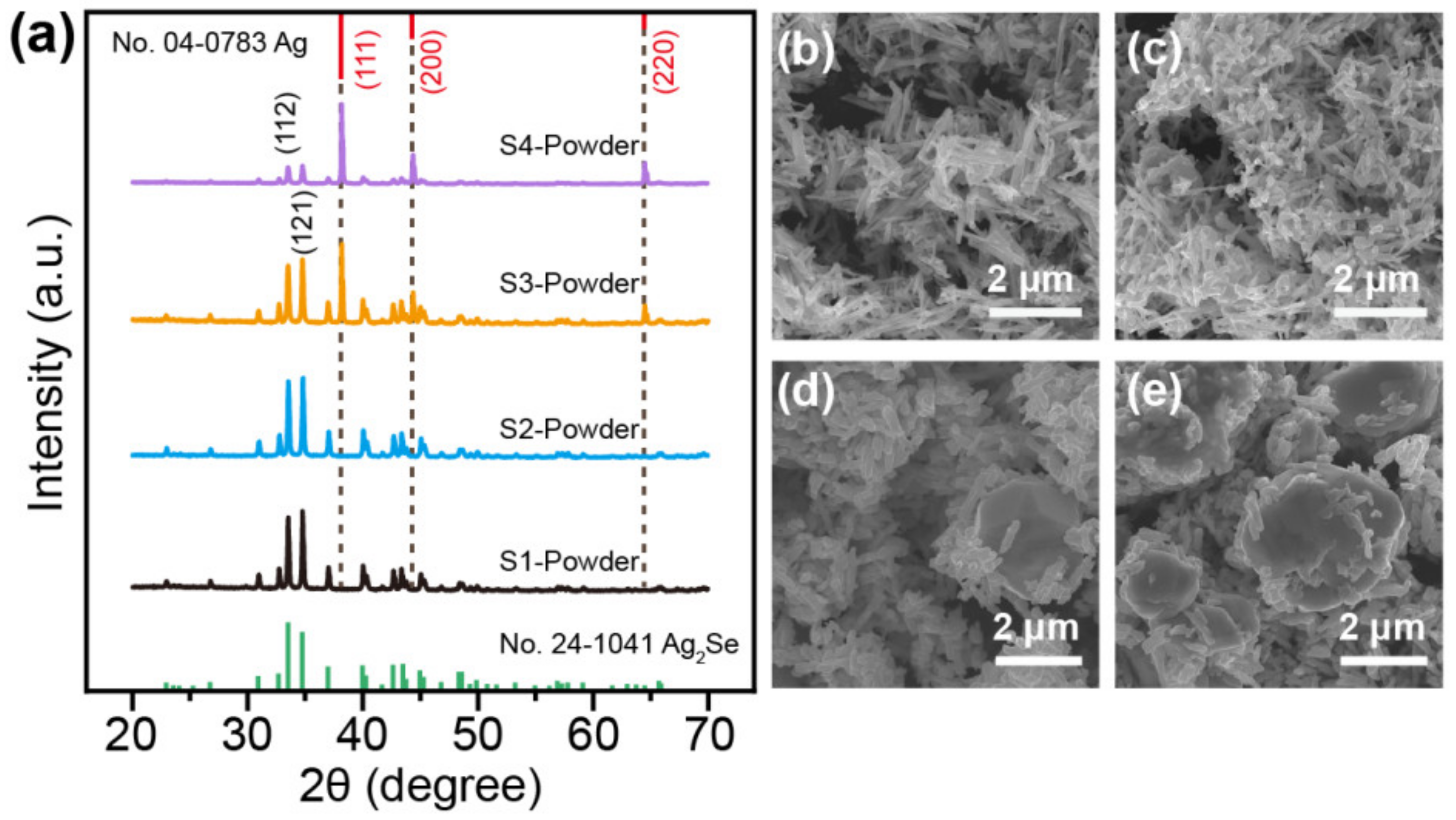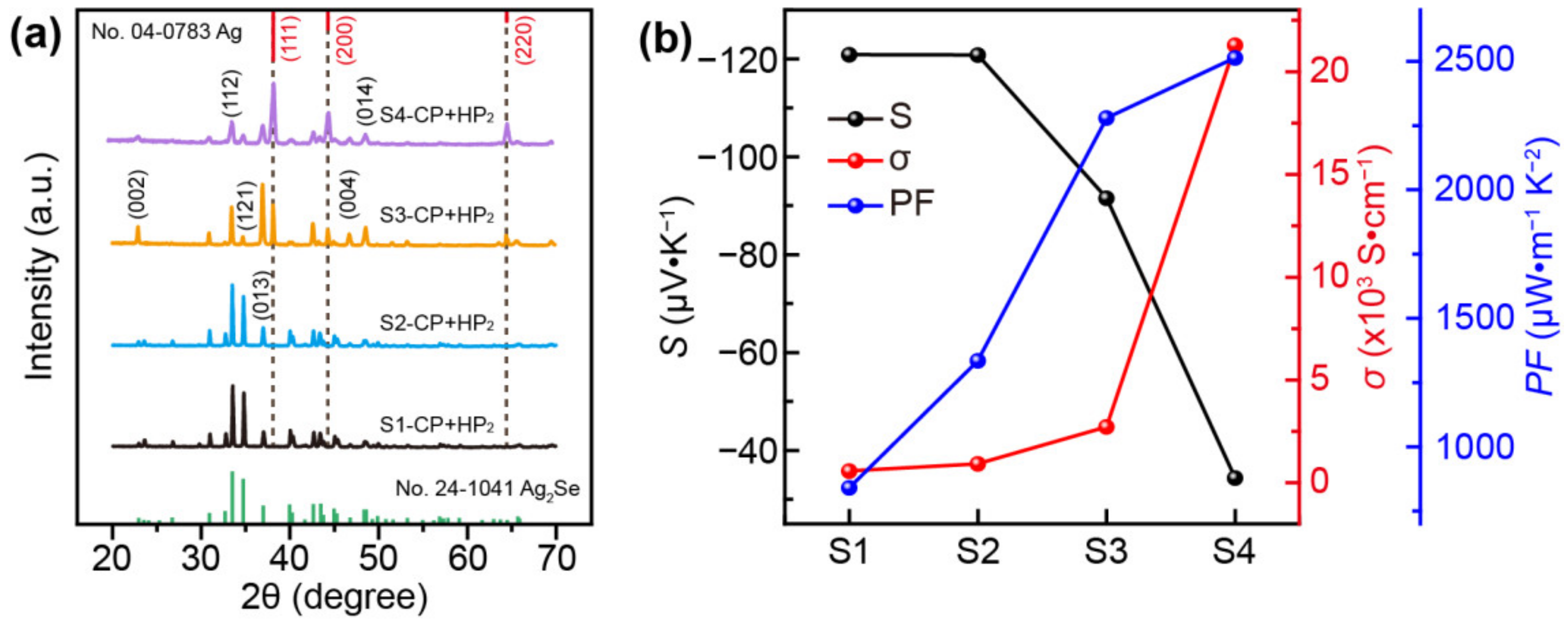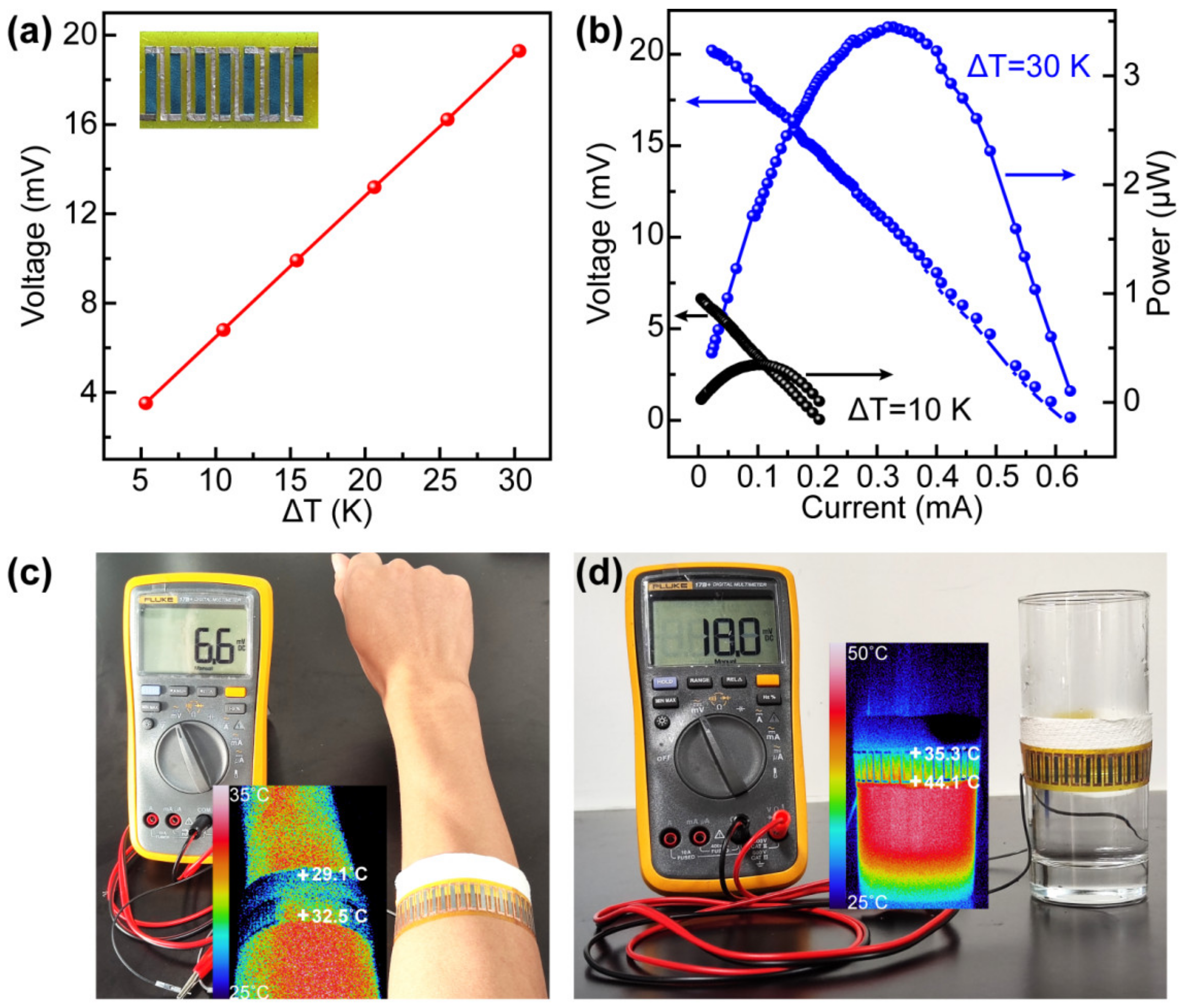High Power Factor of Ag2Se/Ag/Nylon Composite Films for Wearable Thermoelectric Devices
Abstract
:1. Introduction
2. Materials and Methods
2.1. Materials
2.2. Synthesis of Se NWs
2.3. Synthesis of Ag2Se Nanostructures with or without Ag Nanoparticles
3. Results and Discussion
| Material | S (μV·K−1) | σ (S·cm−1) | PF (μW·m−1 K−2) | PDmax l/ΔT2 (μW m−1 K−2) | Ref. |
|---|---|---|---|---|---|
| Ag2Se/Nylon | −140 | 497 | 987 | 51.1 | [28] |
| Ag2Se/Nylon | −143 | 920 | 1882 | 488.9 | [43] |
| Ag2Se/Ag/CuAgSe/Nylon | −45.5 | 10770 | 2232 | 75.57 | [39] |
| Ag2Se/Ag/PEDOT/Nylon | −49.2 | 5957.3 | 1443 | 204 | [44] |
| Ag2Se/SWCNTs/Nylon | −121 | 704 | 1031 | / | [45] |
| Ag2Se/Ag/Nylon | −70 | 3958 | 1861 | 239.8 | [29] |
| Ag2Se/Ag/Nylon | −91.5 | 2720.1 | 2277.3 | 591.7 | This work |
4. Conclusions
Supplementary Materials
Author Contributions
Funding
Institutional Review Board Statement
Informed Consent Statement
Data Availability Statement
Conflicts of Interest
References
- Ates, H.C.; Yetisen, A.K.; Güder, F.; Dincer, C. Wearable devices for the detection of COVID-19. Nat. Electron. 2021, 4, 13–14. [Google Scholar] [CrossRef]
- Gao, J.; Fan, Y.; Zhang, Q.; Luo, L.; Hu, X.; Li, Y.; Song, J.; Jiang, H.; Gao, X.; Zheng, L.; et al. Ultra-robust and extensible fibrous mechanical sensors for wearable smart healthcare. Adv. Mater. 2022, 34, 2107511. [Google Scholar] [CrossRef] [PubMed]
- Yan, S.; Zhang, X.; Liu, J.; Xu, H.; Wen, F.; Li, T.; Cui, J.; Liu, P.; Shen, L.; Cui, Y.; et al. Multiwalled carbon nanotube/graphite powder film for wearable pressure sensors with high sensing performance. Nanomaterials 2022, 12, 2637. [Google Scholar] [CrossRef] [PubMed]
- He, W.; Fu, X.; Zhang, D.; Zhang, Q.; Zhuo, K.; Yuan, Z.; Ma, R. Recent progress of flexible/wearable self-charging power units based on triboelectric nanogenerators. Nano Energy 2021, 84, 105880. [Google Scholar] [CrossRef]
- Luo, J.; Wang, Z. Recent advances in triboelectric nanogenerator based self-charging power systems. Energy Storage Mater. 2019, 23, 617–628. [Google Scholar] [CrossRef]
- Lan, B.; Wu, F.; Cheng, Y.; Zhou, Y.; Hossain, G.; Grabher, G.; Shi, L.; Wang, R.; Sun, J. Scalable, stretchable and washable triboelectric fibers for self-powering human-machine interaction and cardiopulmonary resuscitation training. Nano Energy 2022, 102, 107737. [Google Scholar] [CrossRef]
- Wang, L.; Xu, H.; Huang, F.; Tao, X.; Ouyang, Y.; Zhou, Y.; Mo, X. High-output lotus-leaf-bionic triboelectric nanogenerators based on 2D MXene for health monitoring of human feet. Nanomaterials 2022, 12, 3217. [Google Scholar]
- Sun, Q.; Wang, L.; Ren, G.; Zhang, L.; Sheng, H.; Zhu, Y.; Wang, H.; Lu, G.; Yu, H.; Huang, W. Smart band-aid: Multifunctional and wearable electronic device for self-powered motion monitoring and human-machine interaction. Nano Energy 2022, 92, 106840. [Google Scholar] [CrossRef]
- Du, Y.; Deng, J.; Li, P.; Wen, Y. Energy transfer and redistribution: An approach for unifying vibrational energy harvesting and vibration attenuation. Nano Energy 2020, 78, 105245. [Google Scholar] [CrossRef]
- Tan, D.; Zhou, J.; Wang, K.; Zhao, X.; Wang, Q.; Xu, D. Bow-type bistable triboelectric nanogenerator for harvesting energy from low-frequency vibration. Nano Energy 2022, 92, 106746. [Google Scholar] [CrossRef]
- Yang, Q.; Yang, S.; Qiu, P.; Peng, L.; Wei, T.; Zhang, Z.; Shi, X.; Chen, L. Flexible thermoelectrics based on ductile semiconductors. Science 2022, 377, 854–858. [Google Scholar] [CrossRef]
- Biria, S.; Chen, F.; Pathreeker, S.; Hosein, I. Polymer encapsulants incorporating light-guiding architectures to increase optical energy conversion in solar cells. Adv. Mater. 2018, 30, 1705382. [Google Scholar] [CrossRef]
- Liu, S.; Tian, J.; Wu, S.; Zhang, W.; Luo, M. A bioinspired broadband self-powered photodetector based on photo-pyroelectric-thermoelectric effect able to detect human radiation. Nano Energy 2022, 93, 106812. [Google Scholar] [CrossRef]
- Liu, Z.; Wu, P.; Li, G. A multibeam and surface plasmonic clothing with RF energy-localized harvester for powering battery-free wireless sensor. IEEE Internet Things J. 2022, 9, 13955–13964. [Google Scholar] [CrossRef]
- Bu, Z.; Zhang, X.; Hu, Y.; Chen, Z.; Lin, S.; Li, W.; Xiao, C.; Pei, Y. A record thermoelectric efficiency in tellurium-free modules for low-grade waste heat recovery. Nat. Commun. 2022, 13, 237. [Google Scholar] [CrossRef] [PubMed]
- Bu, Z.; Zhang, X.; Shan, B.; Tang, J.; Liu, H.; Chen, Z.; Lin, S.; Li, W.; Pei, Y. Realizing a 14% single-leg thermoelectric efficiency in gete alloys. Sci. Adv. 2021, 7, 2738. [Google Scholar] [CrossRef]
- Shi, X.; Zou, J.; Chen, Z. Advanced thermoelectric design: From materials and structures to devices. Chem. Rev. 2020, 120, 7399–7515. [Google Scholar] [CrossRef] [PubMed]
- Jiang, Q.; Sun, H.; Zhao, D.; Zhang, F.; Hu, D.; Jiao, F.; Qin, L.; Linseis, V.; Fabiano, S.; Crispin, X.; et al. High thermoelectric performance in n-type Perylene bisimide induced by the soret effect. Adv. Mater. 2020, 32, 2002752. [Google Scholar] [CrossRef] [PubMed]
- Almasoudi, M.; Salah, N.; Alshahrie, A.; Saeed, A.; Aljaghtham, M.; Zoromba, M.S.; Abdel-Aziz, M.H.; Koumoto, K. High thermoelectric power generation by SWCNT/PPy core shell nanocomposites. Nanomaterials 2022, 12, 2582. [Google Scholar] [CrossRef]
- Zhang, L.; Jin, J.; Huang, S.; Tan, B.; Luo, J.; Wang, D.; Liu, D.; Wang, L. Cross-conjugated spiro molecules and single-walled carbon nanotubes composite for high-performance organic thermoelectric materials and generators. Chem. Eng. J. 2021, 426, 131859. [Google Scholar] [CrossRef]
- Bao, D.; Chen, J.; Yu, Y.; Liu, W.; Huang, L.; Han, G.; Tang, J.; Zhou, D.; Yang, L.; Chen, Z. Texture-dependent thermoelectric properties of nano-structured Bi2Te3. Chem. Eng. J. 2020, 388, 124295. [Google Scholar] [CrossRef]
- Lou, L.; Yang, J.; Zhu, Y.; Liang, H.; Zhang, Y.; Feng, J.; He, J.; Ge, Z.; Zhao, L. Tunable electrical conductivity and simultaneously enhanced thermoelectric and mechanical properties in n-type Bi2Te3. Adv. Sci. 2022, 9, 2203250. [Google Scholar] [CrossRef] [PubMed]
- Li, F.; Bo, L.; Zhang, R.; Liu, S.; Zhu, J.; Zuo, M.; Zhao, D. Enhanced thermoelectric properties of Te doped polycrystalline Sn0.94Pb0.01Se. Nanomaterials 2022, 12, 1575. [Google Scholar] [CrossRef]
- Xiao, Y.; Wu, H.; Shi, H.; Xu, L.; Zhu, Y.; Qin, Y.; Peng, G.; Zhang, Y.; Ge, Z.; Ding, X.; et al. High-ranged ZT value promotes thermoelectric cooling and power generation in n-type PbTe. Adv. Energy Mater. 2022, 12, 2200204. [Google Scholar] [CrossRef]
- Bo, L.; Li, F.; Hou, Y.; Zuo, M.; Zhao, D. Enhanced thermoelectric performance of Cu2Se via nanostructure and compositional gradient. Nanomaterials 2022, 12, 640. [Google Scholar] [CrossRef]
- Kanno, T.; Tamaki, H.; Yoshiya, M.; Uchiyama, H.; Maki, S.; Takata, M.; Miyazaki, Y. High-density frenkel defects as origin of n-type thermoelectric performance and low thermal conductivity in Mg3Sb2-based materials. Adv. Funct. Mater. 2021, 31, 2008469. [Google Scholar] [CrossRef]
- Liu, Z.; Sato, N.; Gao, W.; Yubuta, K.; Kawamoto, N.; Mitome, M.; Kurashima, K.; Owada, Y.; Nagase, K.; Lee, C.-H.; et al. Demonstration of ultrahigh thermoelectric efficiency of ~7.3% in Mg3Sb2/MgAgSb module for low-temperature energy harvesting. Joule 2021, 5, 1196–1208. [Google Scholar] [CrossRef]
- Ding, Y.; Qiu, Y.; Cai, K.; Yao, Q.; Chen, S.; Chen, L.; He, J. High performance n-type Ag2Se film on nylon membrane for flexible thermoelectric power generator. Nat. Commun. 2019, 10, 841. [Google Scholar] [CrossRef] [Green Version]
- Gao, Q.; Wang, W.; Lu, Y.; Cai, K.; Li, Y.; Wang, Z.; Wu, M.; Huang, C.; He, J. High power factor Ag/Ag2Se composite films for flexible thermoelectric generators. ACS Appl. Mater. Interfaces 2021, 13, 14327–14333. [Google Scholar] [CrossRef] [PubMed]
- Rama, V.; Edward, S.; Thomas, C.; Brooks, O.Q. Thin-film thermoelectric devices with high room-temperature figures of merit. Nature 2001, 413, 597–602. [Google Scholar]
- Zhu, Y.; Sun, Y.; Zhu, J.; Song, K.; Liu, Z.; Liu, M.; Guo, M.; Dong, X.; Guo, F.; Tan, X.; et al. Mediating point defects endows n-type Bi2 Te3 with high thermoelectric performance and superior mechanical robustness for power generation application. Small 2022, 18, 2201352. [Google Scholar] [CrossRef]
- Huang, S.; Wei, T.; Chen, H.; Xiao, J.; Zhu, M.; Zhao, K.; Shi, X. Thermoelectric Ag2Se: Imperfection, homogeneity, and reproducibility. ACS Appl. Mater. Interfaces 2021, 13, 60192–60199. [Google Scholar] [CrossRef]
- Zhang, Y.; Zhao, Y.; Guo, R.; Zhang, Z.; Liu, D.; Xue, C. Effect of L-ascorbic acid solution concentration on the thermoelectric properties of silver selenide flexible films prepared by vacuum-assisted filtration. Nanomaterials 2022, 12, 624. [Google Scholar] [CrossRef]
- Zhou, H.; Zhang, Z.; Sun, C.; Deng, H.; Fu, Q. Biomimetic approach to facilitate the high filler content in free-standing and flexible thermoelectric polymer composite films based on PVDF and Ag2Se nanowires. ACS Appl. Mater. Interfaces 2020, 12, 51506–51516. [Google Scholar] [CrossRef] [PubMed]
- Ferhat, M.; Nagao, J. Thermoelectric and transport properties of β-Ag2Se compounds. J. Appl. Phys. 2000, 88, 813–816. [Google Scholar] [CrossRef]
- Chen, J.; Sun, Q.; Bao, D.; Liu, T.; Liu, W.; Liu, C.; Tang, J.; Zhou, D.; Yang, L.; Chen, Z. Hierarchical structures advance thermoelectric properties of porous n-type β-Ag2Se. ACS Appl. Mater. Interfaces 2020, 12, 51523–51529. [Google Scholar] [CrossRef]
- Snyder, G.J.; Toberer, E.S. Complex thermoelectric materials. Nat. Mater. 2008, 7, 105–114. [Google Scholar] [CrossRef] [PubMed] [Green Version]
- Kojda, D.; Mitdank, R.; Handwerg, M.; Mogilatenko, A.; Albrecht, M.; Wang, Z.; Ruhhammer, J.; Kroener, M.; Woias, P.; Fischer, S.F. Temperature-dependent thermoelectric properties of individual silver nanowires. Phys. Rev. B 2015, 91, 024302. [Google Scholar] [CrossRef] [Green Version]
- Lu, Y.; Qiu, Y.; Cai, K.; Ding, Y.; Wang, M.; Jiang, C.; Yao, Q.; Huang, C.; Chen, L.; He, J. Ultrahigh power factor and flexible silver selenide-based composite film for thermoelectric devices. Energy Environ. Sci. 2020, 13, 1240–1249. [Google Scholar] [CrossRef]
- Faleev, S.V.; Léonard, F. Theory of enhancement of thermoelectric properties of materials with nanoinclusions. Phys. Rev. B 2008, 77, 214304. [Google Scholar] [CrossRef] [Green Version]
- Chhatrasal, G.; Yaron, A. Energy filtering of charge carriers: Current trends, challenges, and prospects for thermoelectric materials. Adv. Funct. Mater. 2019, 4, 1901789. [Google Scholar]
- Lee, B.; Cho, H.; Park, K.T.; Kim, J.S.; Park, M.; Kim, H.; Hong, Y.; Chung, S. High-performance compliant thermoelectric generators with magnetically self-assembled soft heat conductors for self-powered wearable electronics. Nat. Commun. 2020, 11, 5948. [Google Scholar] [CrossRef] [PubMed]
- Jiang, C.; Ding, Y.; Cai, K.; Tong, L.; Lu, Y.; Zhao, W.; Wei, P. Ultrahigh performance of n-type Ag2Se films for flexible thermoelectric power generators. ACS Appl. Mater. Interfaces 2020, 12, 9646–9655. [Google Scholar] [CrossRef] [PubMed]
- Wang, Z.; Gao, Q.; Wang, W.; Lu, Y.; Cai, K.; Li, Y.; Wu, M.; He, J. High performance Ag2Se/Ag/PEDOT composite films for wearable thermoelectric power generators. Mater. Today Phys. 2021, 21, 100553. [Google Scholar] [CrossRef]
- Geng, J.; Wu, B.; Guo, Y.; Hou, C.; Li, Y.; Wang, H.; Zhang, Q. High power factor n-type Ag2Se/SWCNTs hybrid film for flexible thermoelectric generator. J. Phys. D Appl. Phys. 2021, 54, 434004. [Google Scholar] [CrossRef]





Publisher’s Note: MDPI stays neutral with regard to jurisdictional claims in published maps and institutional affiliations. |
© 2022 by the authors. Licensee MDPI, Basel, Switzerland. This article is an open access article distributed under the terms and conditions of the Creative Commons Attribution (CC BY) license (https://creativecommons.org/licenses/by/4.0/).
Share and Cite
Wu, W.; Liang, Z.; Jia, M.; Li, Y.; Guan, X.; Zhan, Y.; Wen, J.; Luo, J. High Power Factor of Ag2Se/Ag/Nylon Composite Films for Wearable Thermoelectric Devices. Nanomaterials 2022, 12, 4238. https://doi.org/10.3390/nano12234238
Wu W, Liang Z, Jia M, Li Y, Guan X, Zhan Y, Wen J, Luo J. High Power Factor of Ag2Se/Ag/Nylon Composite Films for Wearable Thermoelectric Devices. Nanomaterials. 2022; 12(23):4238. https://doi.org/10.3390/nano12234238
Chicago/Turabian StyleWu, Wenhang, Zheng Liang, Meng Jia, Yuwei Li, Xiongcong Guan, Yunfeng Zhan, Jinxiu Wen, and Jianyi Luo. 2022. "High Power Factor of Ag2Se/Ag/Nylon Composite Films for Wearable Thermoelectric Devices" Nanomaterials 12, no. 23: 4238. https://doi.org/10.3390/nano12234238





